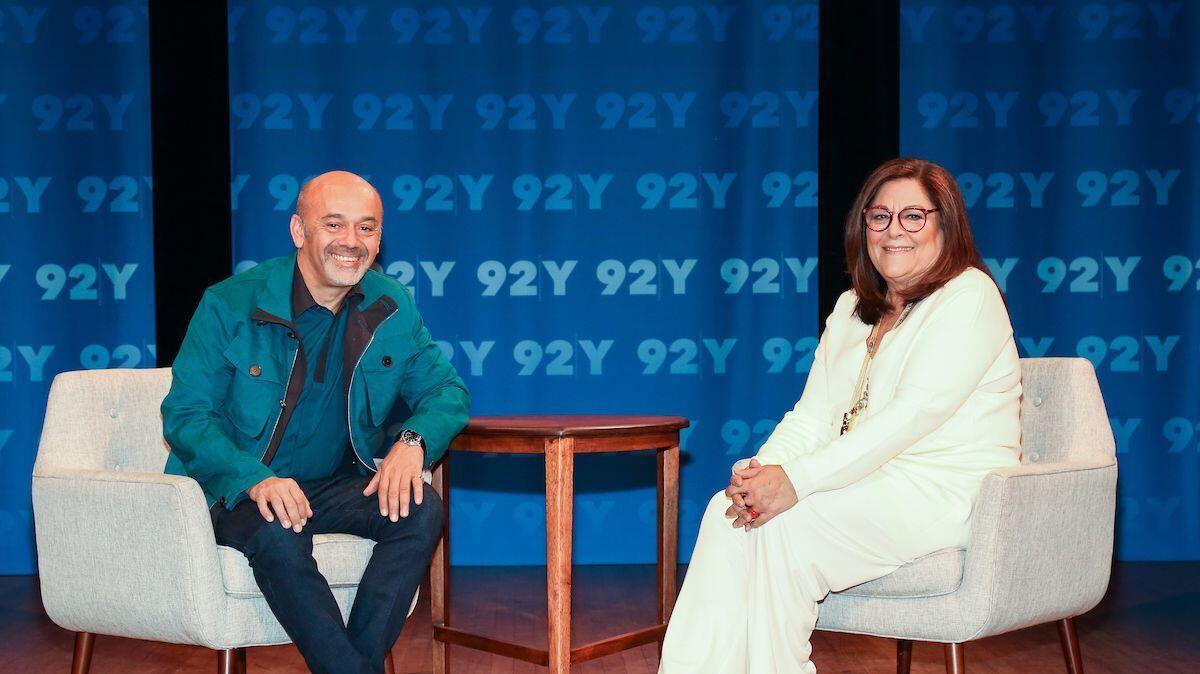Christian Louboutin on his roundabout route to shoe design

Synonymous as his name is with the red-soled sky-high shoes he designs, Christian Louboutin needed no sense of grandeur in describing his own famed life.
In a lengthy question-and-answer session at 92Y with Fern Mallis, he illustrated how an imaginative, mature and impatient boy in Paris wound up being one of the world’s most recognized shoe designers. Put off by the perennial what-would-you-like-to-be-when-you-grow-up question, he simply lied, telling adults, “I want to design shoes,” never thinking it was a real job.
Although a drawing of a high-heeled shoe in a Paris museum was an image that stayed with him for a long time, it wasn’t until years later that the gift of a retrospective book about Roger Vivier (whom he’d never heard of) crystallized his career plans. From that day on, “I really decided it could be and it should be my job,” Louboutin said. “I was all about shoes; I was not about fashion. I had cinema and music but not fashion. When I first started I wanted to design shoes for showgirls.”
After showing his shoe sketches to Folies Bergère, (which he started sneaking into with friends at the age of 12), he was hired as an intern. “But it was a very good way to learn about shoes because for showgirls, they are very important. They have very little costumes in general, so shoes are a strength, a weapon, a posture,” he said. “My first job was to deliver the love letters written by the technicians to the showgirls. My second job was sewing sequins, gluing sequins, brushing the hair, doing the makeup and also some shopping.”
Curious why all the dancers ate veal carpaccio, he asked and was told, “You’re so stupid. We’re not eating it. We’re putting it in the shoes,” rolling it up for cushioning, Louboutin explained.
At 18, he got serious about shoe design, using the Yellow Pages to find couture houses, phoned Christian Dior (after no one answered at Balmain) and “asked to speak to the director of couture. Imagine trying to do that now?” An interview there led to a Charles Jourdan internship, followed by design gigs at Yves Saint Laurent, Chanel and Maud Frizon. He later became an assistant for Roger Vivier but not for design.
While pestering a favorite antique dealer about a lamp he had repeatedly tried to find, the owner asked about his career, suggested he go out on his own and rent the vacant gallery at the end of the street. “He could have said anything to get rid of me anyways,” Louboutin said with a laugh. “I thought, ‘Well, that is an idea.’”
In October 1991, he and two friends opened a Paris store with $150,000, including the price of the lease. There are now 135 boutiques and 400 points of sale in 60 countries. While 4-inch heels were routine in the early days, now seven-inch platforms are the highest, but the designer thinks flat can be sexy, as proven by Brigitte Bardot. His prized “Love” flats were created after seeing a photo of Prince Charles with Princess Diana staring glumly at her size 42 shoes.
Louboutin’s career soared in 1992 after Princess Caroline dropped by his first Paris store en route to antiques dealer Pierre Passebon’s gallery. American buyers soon followed. “I had no collection. I had not yet understood that you had to do one six months ahead and you needed credit,” Louboutin said.
As for how the red sole came to be, Louboutin said he was dissatisfied with the look of a shoe, snagged some red nail polish from a coworker and painted one sole red. “It transformed the shoe and it really became my drawing. I thought, ’This is it. You just have to outline it with color,’” he said, adding that even though his shoppers were partial to all-black ensembles, their red lipstick and fingernails convinced him they would go for red soles.
As a non-TV watcher and France resident, Louboutin was oblivious to HBO’s “Sex and the City.” During a trip to Paris, after Jeffrey Kalinsky urged him to design shoes for the show for the great publicity, he said he told Kalinsky, “‘Yes, I know. They called me but they don’t want to pay.…Nothing is great publicity when it doesn’t pay. That’s my job. I design shoes and people buy them.’”
After Sarah Jessica Parker (whom he described as “a bit of a shoe freak, which is kind of nice”) introduced herself to Louboutin, he said he watched the show. Asked if he’d seen the new shoe collection that Parker is doing, he said, “No, but I don’t watch TV.”
Louboutin was less interested in discussing customers like Asma al-Assad, whose husband Bashar is the President of Syria. “You have a lot of people who are clients. You don’t know them necessarily. I’m not going to speak of people I don’t know,” he said. “I’m not going to speak of Melania Trump. I’m not going to speak of our First Lady [of France Brigitte Macron] or about people who have something to do with politics. That is a thing I will never do.”
Now selling 200,000-plus pairs of men’s shoes each year, Louboutin also has a substantial beauty business which includes red nail polish. “You have to give back to Caesar what belongs to Caesar. The red sole, which is my trademark and a sign of my ambition, started with the nail polish. It’s nice to remember in your flesh exactly where you started,” he said.
ALSO
Pop-up-shop fever and more hits the Los Angeles retail scene
Amber Heard’s Mera costume from ‘Aquaman’ looks like she swam right out of the comic book




